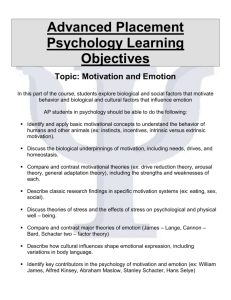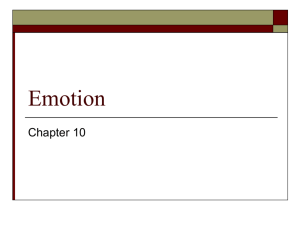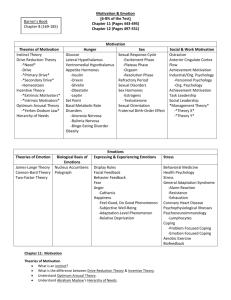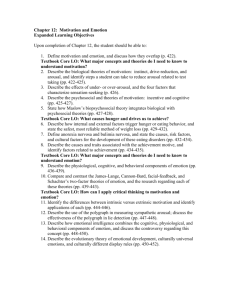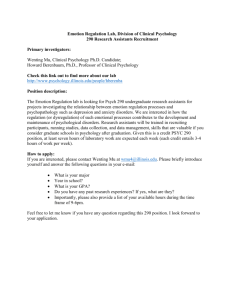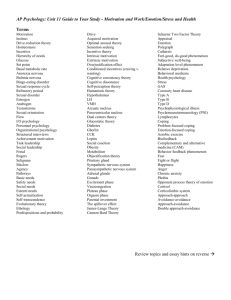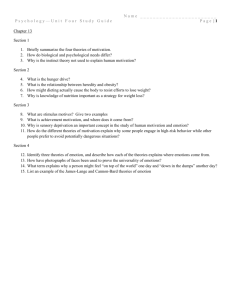Psychology Unit 5: Development & Emotion Syllabus
advertisement
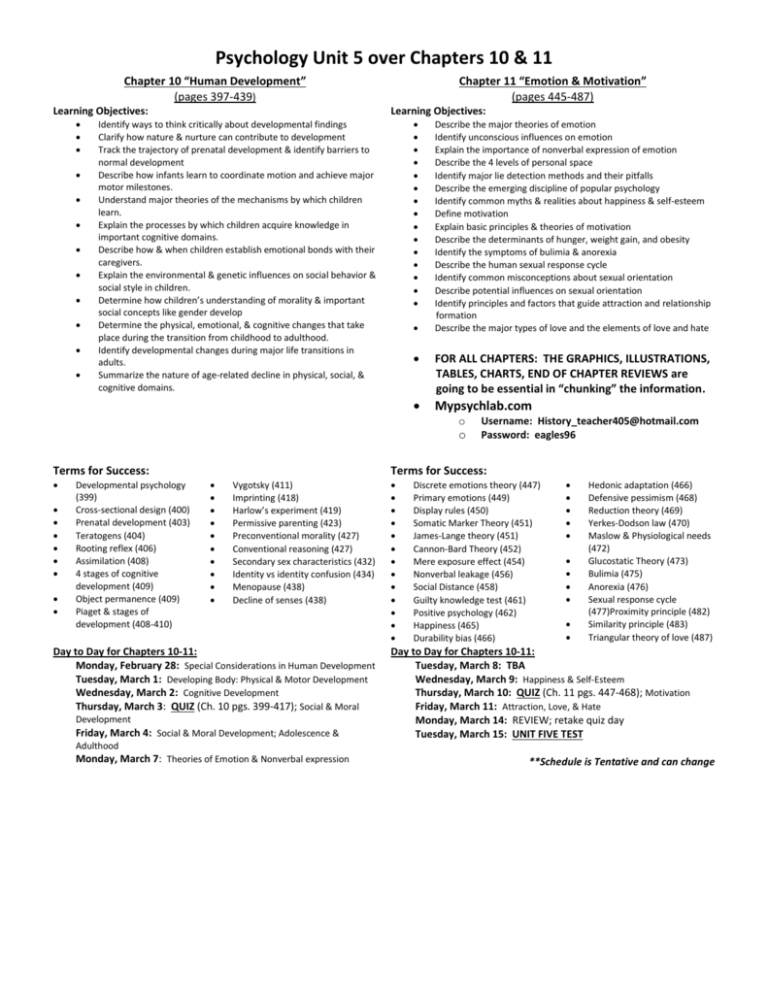
Psychology Unit 5 over Chapters 10 & 11 Chapter 10 “Human Development” (pages 397-439) Learning Objectives: Chapter 11 “Emotion & Motivation” (pages 445-487) Learning Objectives: Identify ways to think critically about developmental findings Clarify how nature & nurture can contribute to development Track the trajectory of prenatal development & identify barriers to normal development Describe how infants learn to coordinate motion and achieve major motor milestones. Understand major theories of the mechanisms by which children learn. Explain the processes by which children acquire knowledge in important cognitive domains. Describe how & when children establish emotional bonds with their caregivers. Explain the environmental & genetic influences on social behavior & social style in children. Determine how children’s understanding of morality & important social concepts like gender develop Determine the physical, emotional, & cognitive changes that take place during the transition from childhood to adulthood. Identify developmental changes during major life transitions in adults. Summarize the nature of age-related decline in physical, social, & cognitive domains. Describe the major theories of emotion Identify unconscious influences on emotion Explain the importance of nonverbal expression of emotion Describe the 4 levels of personal space Identify major lie detection methods and their pitfalls Describe the emerging discipline of popular psychology Identify common myths & realities about happiness & self-esteem Define motivation Explain basic principles & theories of motivation Describe the determinants of hunger, weight gain, and obesity Identify the symptoms of bulimia & anorexia Describe the human sexual response cycle Identify common misconceptions about sexual orientation Describe potential influences on sexual orientation Identify principles and factors that guide attraction and relationship formation Describe the major types of love and the elements of love and hate FOR ALL CHAPTERS: THE GRAPHICS, ILLUSTRATIONS, TABLES, CHARTS, END OF CHAPTER REVIEWS are going to be essential in “chunking” the information. Mypsychlab.com o o Terms for Success: Developmental psychology (399) Cross-sectional design (400) Prenatal development (403) Teratogens (404) Rooting reflex (406) Assimilation (408) 4 stages of cognitive development (409) Object permanence (409) Piaget & stages of development (408-410) Username: History_teacher405@hotmail.com Password: eagles96 Terms for Success: Vygotsky (411) Imprinting (418) Harlow’s experiment (419) Permissive parenting (423) Preconventional morality (427) Conventional reasoning (427) Secondary sex characteristics (432) Identity vs identity confusion (434) Menopause (438) Decline of senses (438) Day to Day for Chapters 10-11: Monday, February 28: Special Considerations in Human Development Tuesday, March 1: Developing Body: Physical & Motor Development Wednesday, March 2: Cognitive Development Thursday, March 3: QUIZ (Ch. 10 pgs. 399-417); Social & Moral Development Friday, March 4: Social & Moral Development; Adolescence & Discrete emotions theory (447) Primary emotions (449) Display rules (450) Somatic Marker Theory (451) James-Lange theory (451) Cannon-Bard Theory (452) Mere exposure effect (454) Nonverbal leakage (456) Social Distance (458) Guilty knowledge test (461) Positive psychology (462) Happiness (465) Durability bias (466) Hedonic adaptation (466) Defensive pessimism (468) Reduction theory (469) Yerkes-Dodson law (470) Maslow & Physiological needs (472) Glucostatic Theory (473) Bulimia (475) Anorexia (476) Sexual response cycle (477)Proximity principle (482) Similarity principle (483) Triangular theory of love (487) Day to Day for Chapters 10-11: Tuesday, March 8: TBA Wednesday, March 9: Happiness & Self-Esteem Thursday, March 10: QUIZ (Ch. 11 pgs. 447-468); Motivation Friday, March 11: Attraction, Love, & Hate Monday, March 14: REVIEW; retake quiz day Tuesday, March 15: UNIT FIVE TEST Adulthood Monday, March 7: Theories of Emotion & Nonverbal expression **Schedule is Tentative and can change
